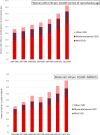Time trends and birth rates in women with congenital heart disease; a nationwide cohort study from Norway 1994-2014
- PMID: 39712532
- PMCID: PMC11657671
- DOI: 10.1016/j.ijcchd.2024.100507
Time trends and birth rates in women with congenital heart disease; a nationwide cohort study from Norway 1994-2014
Abstract
Background: More women with congenital heart disease (CHD) reach reproductive age, but little is known of their success in having children. We investigated time trends of CHD in women of reproductive age and maternal CHD in childbirth and compared birth rates in women with CHD to birth rates in women without heart disease.
Methods and results: In a national cohort, we combined information from five registries in Norway 1994-2014. Among 1,644,650 women aged 15-45 years, 5672 had CHD. Among 1,183,851 childbirths, 3504 were registered with maternal CHD. The prevalences of mild and moderate/severe CHD in women increased by an average of 3-4% per year 1994-2014, as did the prevalences of mild and moderate/severe maternal CHD in childbirth. Compared to women without heart disease, the likelihood of having children was similar for women with mild CHD (rate ratio 1.03, 95% confidence interval 0.97-1.09) but lower for women with moderate/severe CHD (rate ratio 0.75, 95% confidence interval 0.68-0.84). The mean number of childbirths was similar in women with mild CHD and women without heart disease (1.81 vs 1.80, p = 0.722) but lower in women with moderate/severe CHD (1.42, p < 0.001).
Conclusion: In a national cohort over two decades of women of reproductive age, the prevalence of maternal CHD in childbirth reflected the increasing prevalence of CHD in the population. Birth rates were similar for women with mild CHD and women without heart disease, whereas women with moderate/severe CHD were less likely to have children and had a lower mean number of childbirths.
Keywords: Birth rate; Congenital heart disease; Epidemiology; Fertility; Prevalence; Reproductive health.
© 2024 The Author(s).
Conflict of interest statement
The authors declare that they have no known competing financial interests or personal relationships that could have appeared to influence the work reported in this paper.
Figures




Similar articles
-
Labor onset and delivery mode in women with congenital heart disease-A nationwide cohort study.Acta Obstet Gynecol Scand. 2025 Apr;104(4):666-675. doi: 10.1111/aogs.15064. Epub 2025 Jan 29. Acta Obstet Gynecol Scand. 2025. PMID: 39878100 Free PMC article.
-
Preeclampsia and neonatal outcomes in pregnancies with maternal congenital heart disease: A nationwide cohort study from Norway.Acta Obstet Gynecol Scand. 2024 Sep;103(9):1847-1858. doi: 10.1111/aogs.14902. Epub 2024 Jul 1. Acta Obstet Gynecol Scand. 2024. PMID: 38946266 Free PMC article.
-
Time to childbirth and assisted reproductive treatment in women with congenital heart disease.Open Heart. 2024 Mar 13;11(1):e002591. doi: 10.1136/openhrt-2023-002591. Open Heart. 2024. PMID: 38485120 Free PMC article.
-
The birth prevalence, severity, and temporal trends of congenital heart disease in the middle-income country: A population-based study.Congenit Heart Dis. 2018 Nov;13(6):1012-1027. doi: 10.1111/chd.12672. Epub 2018 Oct 5. Congenit Heart Dis. 2018. PMID: 30289622
-
Maternal and Neonatal Outcomes of Pregnancies in Women With Congenital Heart Disease: A Meta-Analysis.J Am Heart Assoc. 2021 Apr 20;10(8):e017834. doi: 10.1161/JAHA.120.017834. Epub 2021 Apr 6. J Am Heart Assoc. 2021. PMID: 33821681 Free PMC article. Review.
Cited by
-
Labor onset and delivery mode in women with congenital heart disease-A nationwide cohort study.Acta Obstet Gynecol Scand. 2025 Apr;104(4):666-675. doi: 10.1111/aogs.15064. Epub 2025 Jan 29. Acta Obstet Gynecol Scand. 2025. PMID: 39878100 Free PMC article.
-
The modified WHO class is associated with maternal complications in women with congenital heart disease.Eur Heart J Open. 2025 Jun 21;5(4):oeaf081. doi: 10.1093/ehjopen/oeaf081. eCollection 2025 Jul. Eur Heart J Open. 2025. PMID: 40642483 Free PMC article.
References
-
- van der Linde D., Konings E.E., Slager M.A., Witsenburg M., Helbing W.A., Takkenberg J.J., Roos-Hesselink J.W. Birth prevalence of congenital heart disease worldwide: a systematic review and meta-analysis. J Am Coll Cardiol. 2011;58(21):2241–2247. - PubMed
-
- Khairy P., Ionescu-Ittu R., Mackie A.S., Abrahamowicz M., Pilote L., Marelli A.J. Changing mortality in congenital heart disease. J Am Coll Cardiol. 2010;56(14):1149–1157. - PubMed
-
- Moons P., Luyckx K., Thomet C., Budts W., Enomoto J., Sluman M.A., et al. Physical functioning, mental health, and quality of life in different congenital heart defects: comparative analysis in 3538 patients from 15 countries. Can J Cardiol. 2021;37(2):215–223. - PubMed
LinkOut - more resources
Full Text Sources

